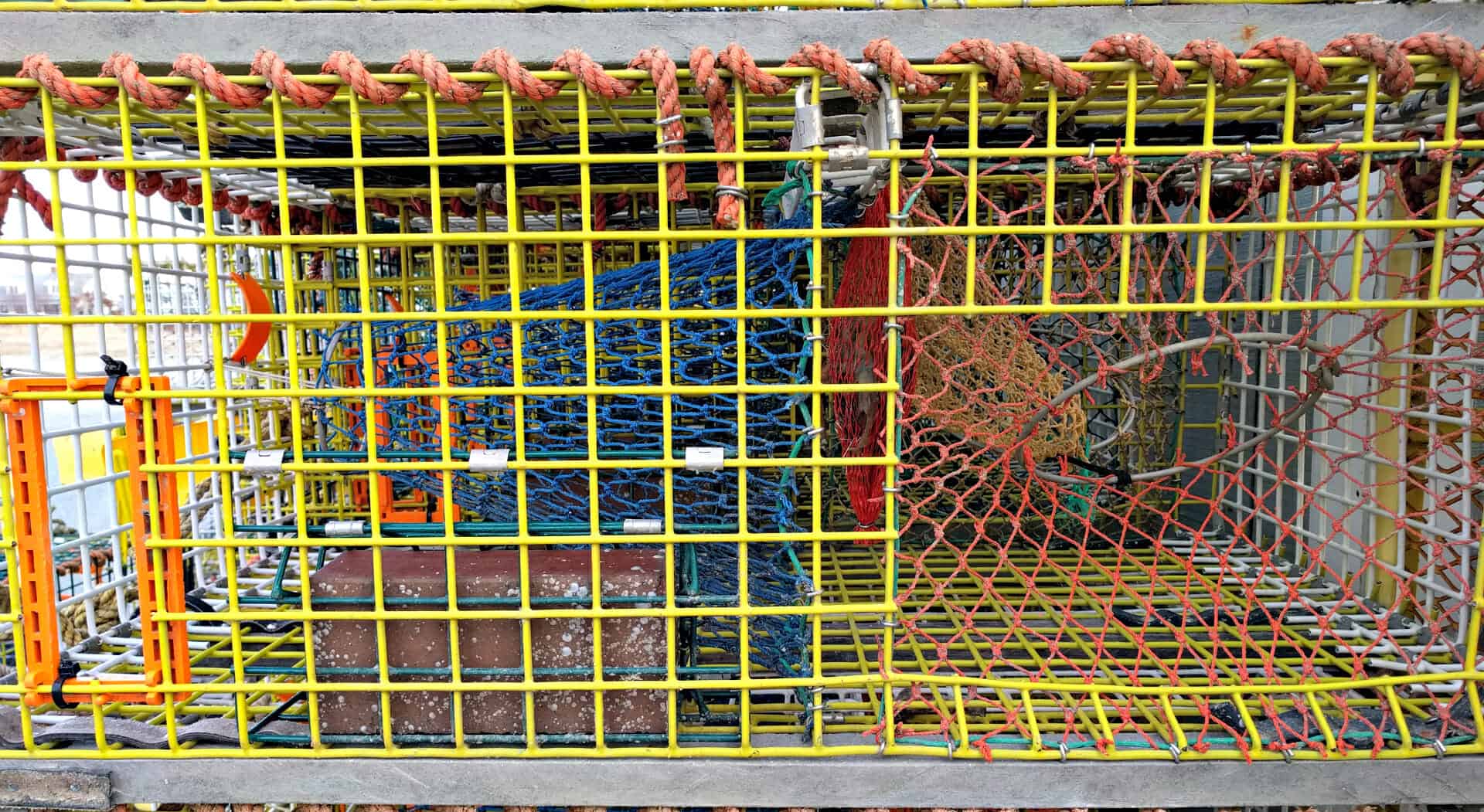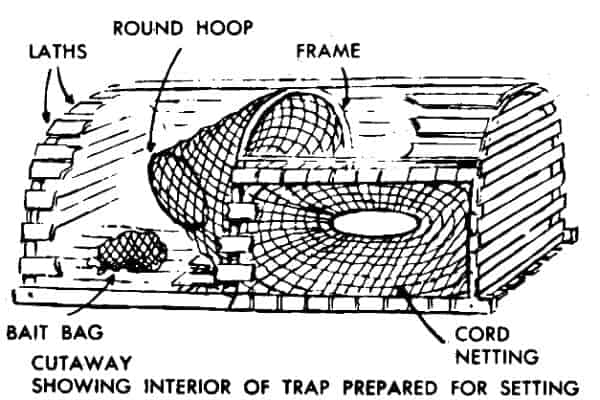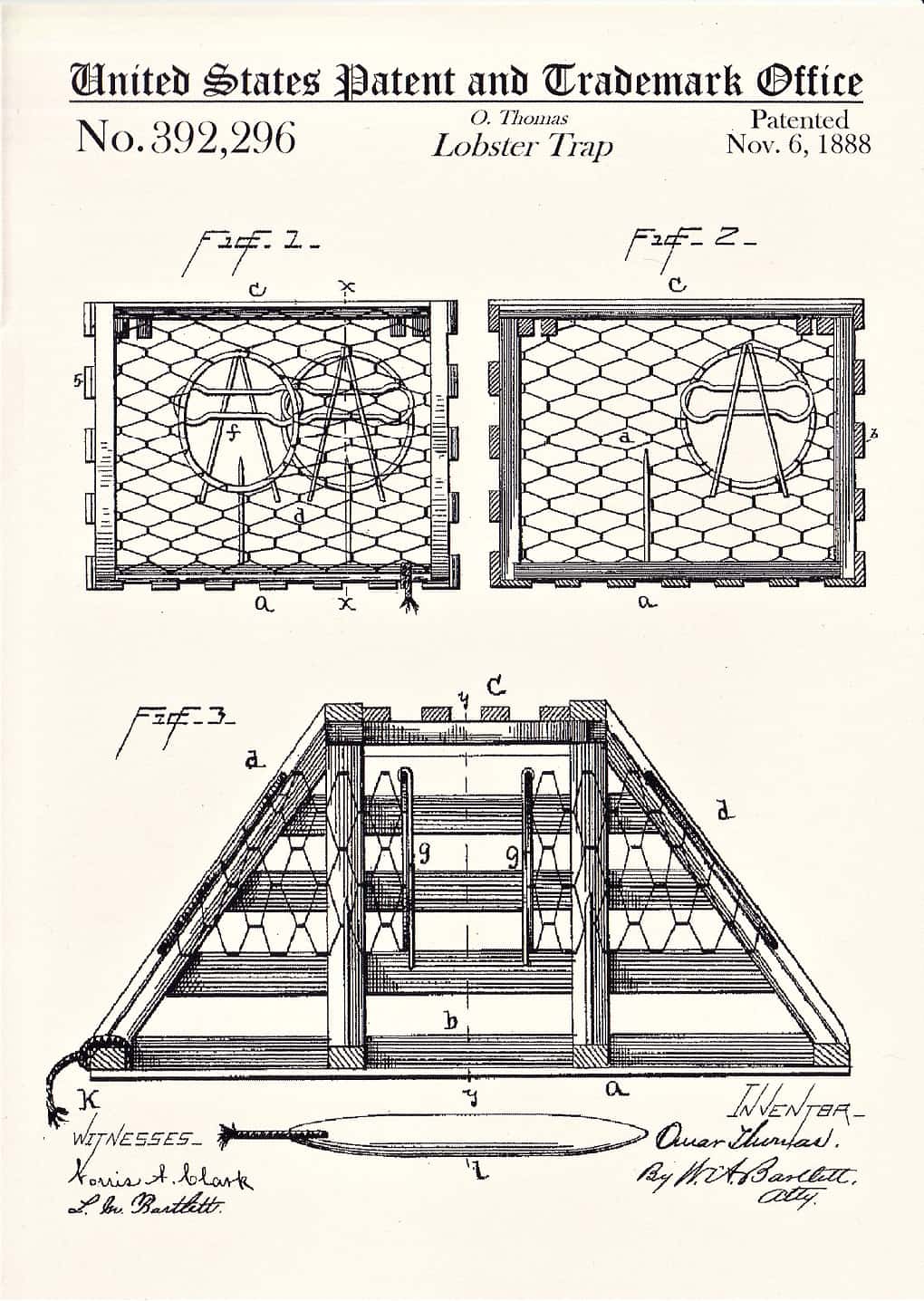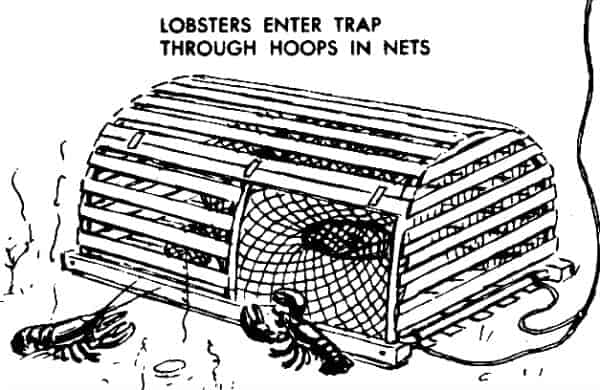Next to the boat and a motor, the lobster trap has been the indispensable tool for fishermen for more that 200 years. Invented in 1809 by Ebenezer Thorndike of Swampscott, Massachusetts, the lobster trap revolutionized lobster fishing. Little has changed in the design of the trap and the hard work it takes for the independent lobstermen and women to bring lobster from Maine to your table.

Except for those caught by deep sea trawlers, lobsters are still caught in lobster traps (also called pots). As traps used to be made of wood, metal traps emerged 20 years ago that are lighter and can withstand salt water erosion. Plus the rectangular metal traps stack better than the rounded wood-slat traps. The wire-mesh cages have round openings with bait inside to entice lobsters to crawl in.
Wood traps were built and maintained by lobster fisherman in the winter months when the seas were too rough for fishing. Pulling wooden traps from the water was no easy task — they weighed more than 80 pounds when wet — until motorized pot haulers were developed to ease the burden of fishermen.
Setting Lobster Traps
A fisherman’s daily trap location is the most important factor in his catch success. Lobstermen lay their traps on rocky crevices and patches of seaweed where lobsters like to hide. Lobsters troll the ocean floor in depths of water less than 100 feet, but can be found in as much as 1000 feet below water! Lobsters hide in sand or rocks during the day. They are nocturnal and hunt for food by using their antennas to smell and find prey. Lobsters eat everything living or dead including mollusks, worms, fish, sea urchins, crabs and even other lobsters.
Salted Herring is the prefered bait fish used by lobstermen to lure and trap lobsters. When there is a Herring shortage, bait prices increase, impacting the lobstermen’s bottom line. Bluefish, Cod, Mackerel, and Menhaden (known as Pogeys) are also used as bait.

According to the Department of Marine Resources, lobster traps also catch fish species like sculpin longhorn, sea raven, cunner, cod, redfish, cusk, flatfish, mackerel and horseshoe crab.
Hauling Lobster Traps
Each lobster season, Maine coastal waters are dotted with bright colored buoys that mark a lobsterman’s lines of traps. The some 3 million traps off the coast of Maine are distinguished by color patterns and design distinct to each owner. Each lobsterman is limited to 800 traps in the water at one time. Beneath the surface, each trap is secured by a concrete block connected by the buoy by rope or the warp. Traps are set on the seafloor and sit for a length of time ranging from one tide (six hours) to several days. Most lobstermen check their traps in one day.

Lobstermen retrieve their traps by using a hooked pole (called a ‘gaff’) to raise the trap by hand or pulley to the edge of the boat. Lobsters short of regulation size or females with eggs are returned to sea. A lobster is measured by its carapace – the dorsal section not including the head, claws or tail – which must measure at least 3 and 1/4 inches but no more than 5 inches.

Lobster Trap Design
A traditional lobster trap has two components. The outer compartment has 1-2 funnels of nylon netting leading inside the trap. Lobsters attracted by the bait move into one of the funnels. The inner component, called the ‘parlor,’ is baited with salted herring or haddock. By the time they take the bait and reach the parlor, the lobsters are trapped.
- Kitchen: The ‘kitchen’ is the entry to the trap. It is funnel shaped and made of netting. Flat cement blocks or bricks are placed in the kitchen area to weigh down the trap so it hits the ocean floor flat. Traps are set between 20-30 feet of water.
The success and sustainability of the Maine lobster fishery is due in large part to the design of the trap. It is estimated that for every 20 lobsters that enter the trap, only one is caught! However, the inefficient design also requires longer days, resources, and fuel from the lobstermen who harvest them.

Maine Made Lobster Trap Companies
Two of the largest lobster trap companies in Maine are Friendship Trap, founded in 1977; and Brooks Trap Mill, founded in 1946. In addition to manufacturing and selling traps, both companies offer trap kits for lobstermen who want to build their own.
Searose Lobster Trap Co. of Scarborough, ME sells trap wire and supplies and also makes unique lobster trap furniture. The lobster trap rocking chair is Searose’s bestseller.
Lobster From Maine, but No Trap Needed!
Lobster lovers don’t need a trap to enjoy live lobster from Maine. Since 1999, LobsterAnywhere.com ships live, quality hard shell lobsters delivered to your doorstep within 24 hours (in the continental U.S.). View our lobster specials and if your looking to send a special lobster dinner, checkout our unique seafood gift packages.
